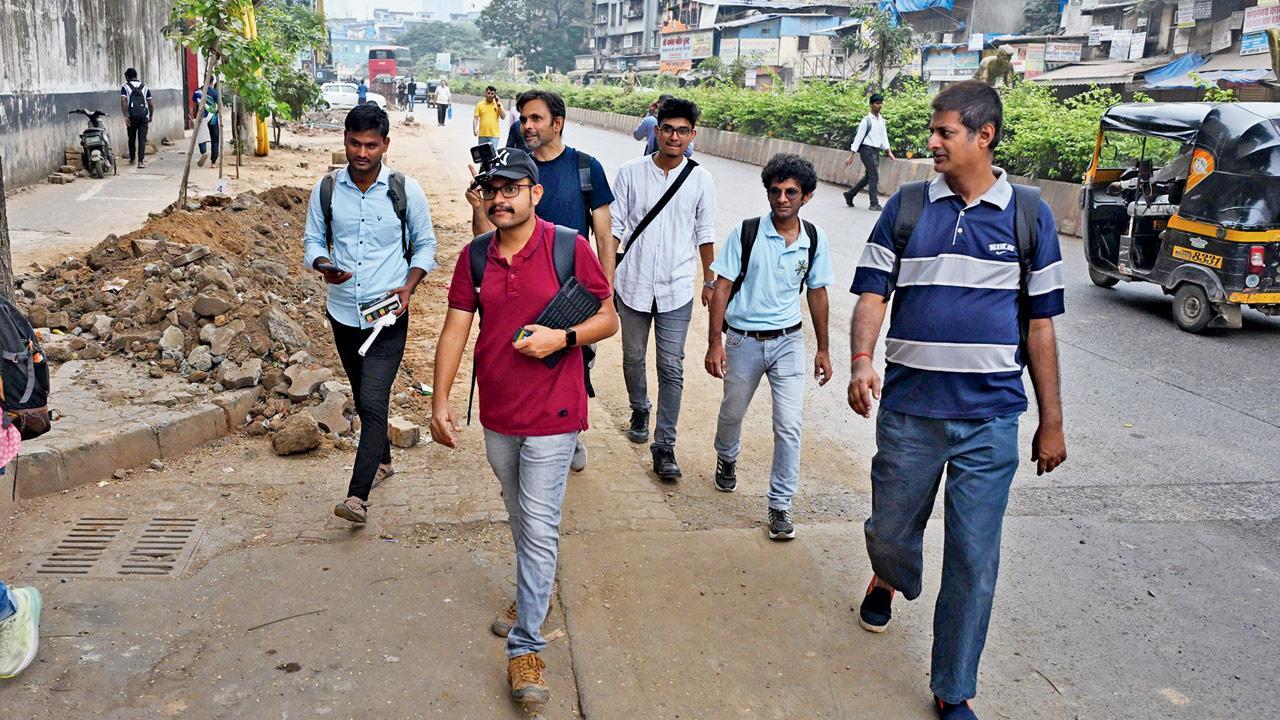The Walking Project takes citizens through high footfall paths to survey hurdles that they can pull up city planners for

Acceptable limit of PM2.5 in India is 40 micrograms per cubic meter (µg/m3) as per the Pollution Control Board.
A recent two-KM community walk in Bandra East served a raw wake-up call about urban walkability to Dhanraj Khair. The 22-year-old architecture student is in final year at LS Raheja College. The walk was organised by The Walking Project, a citizen advocacy group established in 2012 for safer, more enjoyable pedestrian experiences across cities. The walks give citizens firsthand exposure to the challenges in urban infrastructure, aiming to align public awareness with the Indian Roads Congress (IRC) standards, which detail ideal footpath width, railings, and other pedestrian-friendly elements.
ADVERTISEMENT
Khair was one of only seven citizens who braved the challenging route from Bandra Station’s east exit to BKC Metro Station via Kalanagar. They assessed pedestrian infrastructure, walkability, and air quality along the route. Khair describes the walk as, “overwhelming, nauseating, and chaotic. Before you even descend the staircase to exit the station, you’re swarmed by shared auto-rickshaw drivers. The roads to Bandra Court are dug up, forcing crowds onto the roads.”
“By exposing participants to the reality versus what IRC guidelines recommend, we aim to drive citizen advocacy from a place of genuine awareness and personal experience,” Vedant Mhatre of The Walking Project explained. “Through 27 community walks so far, we’ve hosted over 270 citizens.” Interestingly, the Bandra East walk had lower attendance. “Some potential participants backed out citing dangerous conditions as a deterrent,” he says.
To Khair, the experience underscored the urgent need for municipal action: “It’s impossible to think of walkability as a convenience when it’s a constant fight for space and safety.” Over seven years ago, Maharashtra introduced an urban transport policy aimed at developing infrastructure to support walking, cycling, and public transportation, as well as to alleviate traffic congestion.
Yet, in Mumbai, walking remains a challenge. In 2022, the Mumbai Climate Action Plan (MCAP) highlighted that only 22 per cent of the city’s 2,000-km road network is pedestrian-friendly. To reduce pedestrian-vehicular conflict, MCAP has recommended city planning authorities develop a Non-Motorised Transport (NMT) policy for the city by 2035. Additionally, it has set a timeline to planning bodies to initiate pedestrianisation pilot projects in high-footfall areas by 2025.
These include better signage near crossings, longer signal times for pedestrians, and more walkways in low-income areas. According to BMC’s 2016 Comprehensive Mobility Plan, 51 per cent of all trips are made on foot; and 72.5 per cent of trips to educational institutions and 60 per cent of public transport journeys beginning and ending with walking.
“The footpaths along the route were in terrible condition,” reflects Khair, “there are dug-up roads and obstacles along the MHADA building compound near Kherwadi, and beyond the road opposite Matoshree. The raised borders around trees and plants on the footpaths are at least a brick high; they narrow the already limited space.”
Kedar Sohoni, of Green Communities Foundation, was also part of the walk. “You have to be an acrobat to navigate the area,” he said, “There’s no smooth path, and you’re constantly on edge. I can only imagine how hard it must be for seniors or those with physical limitations.” mid-day recently concluded a three-part special series examining the traffic chaos, gridlock, and severe air pollution issues at BKC, along with a few potential solutions.
AQI on Saturday, 8.30 AM - 10 AM
Bandra Station (E)
105µg/m3
Kalanagar junction
93 µg/m3
BKC metro station
99 µg/m3
Gurunanak Hospital
114 µg/m3
 Subscribe today by clicking the link and stay updated with the latest news!" Click here!
Subscribe today by clicking the link and stay updated with the latest news!" Click here!







